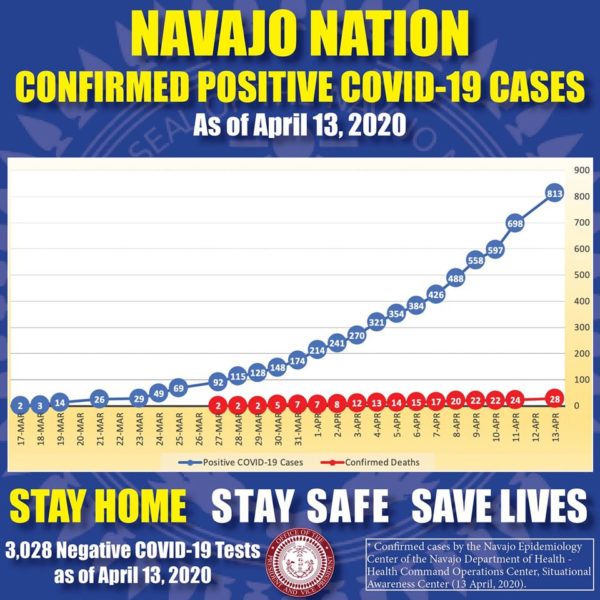
- Details
- By Levi Rickert
WINDOW ROCK, Ariz. — The total cases of confirmed cases of the COVID-19 (novel coronavirus) has surpassed 800 and as of Monday evening stand at 813. These new numbers were just released on Monday evening by the Navajo Nation. The new total represents an increase of 115 since Saturday evening. The Navajo Nation did not released an update on Sunday evening due to the Easter.
The death toll stands at 28 related to COVID-19, which represents an increase of four since Saturday.
The Navajo Department of Health and Navajo Area Indian Health Service, in coordination with the Navajo Epidemiology Center, report also 3,028 total negative test results as of Thursday.
The 813 confirmed positive cases include the following counties:
- NavajoCounty, AZ: 269
- Apache County, AZ: 102
- Coconino County, AZ: 165
- McKinley County, NM: 138
- San Juan County, NM: 108
- Cibola County, NM: 11
- San Juan County, UT: 11
- Socorro County, NM: 6
- Sandoval County, NM: 3
"It’s very saddening to receive the new numbers each day. There are a lot of grieving families and there is a lot of work yet to be done. It’s our time to rise to the challenge and keep pushing forward for our people and to honor those who have lost their lives to this virus. We will not give up. We saw good results with the 57-hour curfew this past weekend and we are considering a similar curfew once again to help decrease the spread. Our police officers did a great job!” Navano Nation President Jonathan Nez said on Monday evening.
On Monday, the Navajo Area Indian Health Service also reported that they are beginning to receive rapid COVID-19 test kits that will begin producing quicker results at health care facilities on the Navajo Nation. Results were previously taking an average of three to four days to confirm.
Navajo Nation officials believe the coronavirus curve has not reached its apex yet.
“The upcoming weeks are going to be very challenging and we need everyone to support one another. This is an opportunity to show the world our strong we are as Diné people and to demonstrate our resilience once again. Let’s pray, let’s make good choices for ourselves and others, and let’s thank our health care workers and everyone else on the frontlines fighting for us each day,” said Vice President Lizer.

“The enforcement was successful in that we saw a decline in the number of people traveling during the weekend. An operation of this capacity takes a lot of planning and coordination and our districts did a great job in enforcement efforts. In addition, the success is also credited to the public who complied and stayed home,” Police Chief Francisco said. “I also want to remind the public that the stay at home order and daily curfew orders remain in effect and we ask the public to continue to adhere to those orders.”
The Navajo Nation’s daily curfew remains in effect from 8:00 p.m. to 5:00 a.m. and Navajo Police continue to issue citations for curfew violators. On Tuesday, President Nez and Vice President Lizer will host another online Town Hall to share COVID-19 updates beginning at 10:00 a.m. (MDT) on the Nez-Lizer Facebook page.
For more information including reports, helpful prevention tips, and more resources, please visit the Navajo Department of Health’s COVID-19 website at http://www.ndoh.navajo-nsn.gov/COVID-19. To contact the main Navajo Health Command Operations Center, please call (928) 871-7014.
For up to date information on impact the coronavirus pandemic is having in the United States and around the world go to: https://www.worldometers.info/coronavirus/country/us/?fbclid=IwAR1vxfcHfMBnmTFm6hBICQcdbV5aRnMimeP3hVYHdlxJtFWdKF80VV8iHgE
For up-to-date information about COVID-19, Native News Online encourages you to go to Indian Health Service’s COVID-19 webpage and review CDC’s COVID-19 webpage.
How to help Native News Online: Send us news. Sign up for our daily enewsletter. Follow us on Facebook and Twitter. Share our articles. You can also donate to Native News Online here. Most importantly, take care of yourself. Megwetch.
More Stories Like This
Native News Weekly (August 25, 2024): D.C. BriefsUS Presidents in Their Own Words Concerning American Indians
Native News Weekly (December 14, 2025): D.C. Briefs
Wounded Knee Massacre Site Protection Bill Passes Congress
Two Murdered on Colville Indian Reservation
Help us defend tribal sovereignty.
At Native News Online, our mission is rooted in telling the stories that strengthen sovereignty and uplift Indigenous voices — not just at year’s end, but every single day.
Because of your generosity last year, we were able to keep our reporters on the ground in tribal communities, at national gatherings and in the halls of Congress — covering the issues that matter most to Indian Country: sovereignty, culture, education, health and economic opportunity.
That support sustained us through a tough year in 2025. Now, as we look to the year ahead, we need your help right now to ensure warrior journalism remains strong — reporting that defends tribal sovereignty, amplifies Native truth, and holds power accountable.
 The stakes couldn't be higher. Your support keeps Native voices heard, Native stories told and Native sovereignty defended.
The stakes couldn't be higher. Your support keeps Native voices heard, Native stories told and Native sovereignty defended.
Stand with Warrior Journalism today.
Levi Rickert (Potawatomi), Editor & Publisher

